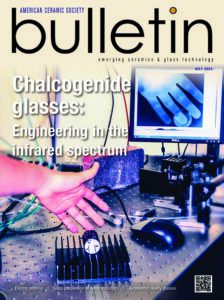
Title: Evolving the lever rule for borate glass structure
Abstract: A new approach to quantifying the short-range structural units of glass forming melts has been developed by evolving the classical lever rule. The nodes of the traditional lever rule are reimagined as ‘Short-Range Order Configurations’ (SROCs) that allow for proper accounting of disproportionation and isomerization of chemical species. The simplicity is that only the short-range structure of just a few glasses needs to be determined, then any composition can be considered as a linear combination of the bounding SROCs. The model is first constructed and then applied to the binary zinc borate system over the entire glass forming region. Experimentally, the xZnO-(1-x)B2O3 system is investigated with NMR, Raman, and IR spectroscopies along with density and DSC measurements. By finding the meta-, pyro-, and orthoborate SROCs, the short-range structure of binary zinc borate glasses is modeled. Correspondence with experimental data is excellent, with predicted density within 0.1% and N4 within 1% of experimental values.
Brian Topper is a post-doctoral fellow at Clemson University in Clemson, South Carolina, USA. He received a BS in Physics from the University of Richmond and an MSc in Materials Science and Engineering from Alfred University. His doctoral work in Optical Science and Engineering was carried out under the supervision of Arash Mafi at the University of New Mexico working on high power laser cooling of ytterbium doped silica. He has authored/co-authored 19 peer-reviewed publications, 1 book chapter, and 18 conference contributions in optics, spectroscopy, and glass science. Brian received the Oldfield Award from the Society of Glass Technology in 2021 for his MSc thesis on highly modified borate glasses. Brian, an ACerS member since 2018, shared the Varshneya-Mauro-Jain Guru-Chela award from GOMD with MSc thesis supervisor, Doris Möncke (Alfred University). He is currently working on fabrication of optical fiber for high energy laser systems at Clemson University’s Center for Optical Materials Science and Engineering Technology (COMSET).
Subscribe to Ceramic Tech Today

Don’t miss the latest ceramic and glass materials news. Receive the CTT newsletter to your email three times a week by subscribing at this link.
Subscribe to Ceramic & Glass Manufacturing Weekly

Don’t miss the latest ceramic and glass business news. Receive the C&GM Weekly newsletter to your email every Monday by subscribing at this link.


